Modern minimalist wall art epitomizes the concept of ‘less is more,’ bringing elegance through simplicity into homes and offices alike.
By stripping down to the fundamental elements of design, this style emphasizes clean lines, uncluttered spaces, and a monochromatic or restricted color palette. It’s not only about aesthetic appeal; it reflects a mindset that prioritizes serenity and clarity amidst the noise of modern life. Modernist artists sought to break free from the complex expressions of preceding movements, focusing instead on minimalism’s potential to evoke emotional responses using minimal visual elements.
In integrating modern minimalist wall art into our living or workspace, we invite a sense of sophistication and calm. These pieces can stand alone as a focal point or complement a room’s existing decor, harmonizing with modern furniture and design features. When selecting these art pieces, it’s essential to consider their placement, as the space around the artwork becomes an extension of the piece itself.
This holistic approach ensures that the minimalism on the wall translates into an ambient minimalism throughout the environment, creating continuity and flow.
Key Takeaways
- Modern minimalist wall art employs simple designs to create visual impact and establish tranquility in a space.
- Placement and harmony with room decor are crucial when choosing minimalist art pieces.
- Continual trends and innovations keep modern minimalist wall art at the forefront of contemporary design discussions.
Understanding Modern Minimalist Wall Art
Modern minimalist wall art is not just about simplicity; it’s about the power and elegance that come from meticulous design choices. We’ll explore its defining characteristics, its modern appeal, and the crucial role of negative space.
Defining Minimalism in Art
Minimalism in art focuses on the essentials. It strips away the unnecessary, leaving only the fundamental elements. Minimalist art is marked by clean lines and abstract forms. It commands attention not through complexity but through elegant simplicity. In modern minimalist wall art, each line, color, and texture holds significant weight.
The Appeal of Modern Aesthetics
Modern aesthetics value the “less is more” approach. Clean lines and uncluttered spaces are at the heart of modern design, embodying a sense of calmness and sophistication. Modern minimalist wall art aligns with contemporary preferences for cleanliness and understated elegance, serving as a reflection of the times we live in, where clarity and focus are paramount.
The Role of Negative Space in Wall Art
Negative space is the area around and between the subjects of an image and is a key element in minimalist art. It’s in using this space that a piece of art can convey a powerful message with minimal detail. The strategic use of negative space in modern minimalist wall art enhances the piece’s focal point, promoting a contemplative and serene atmosphere.
Types of Modern Minimalist Wall Art
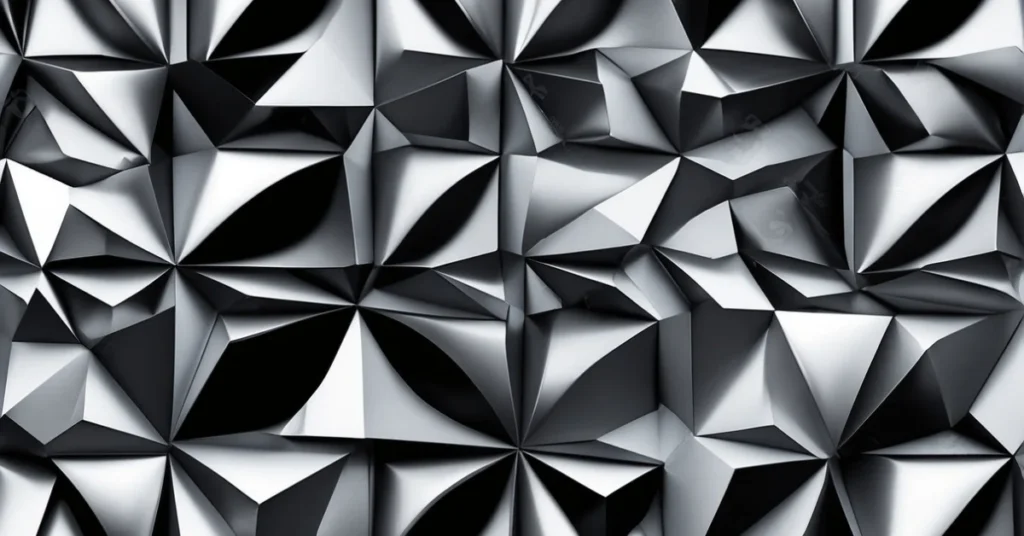
Abstract Art
Our first focus is on abstract minimalist art. This style uses simple color schemes and forms to evoke emotions and thoughts. An excellent example of this is the “No Evil Allowed” by Shatha Al Dafai, where the use of space and simple lines tells a story without the need for detailed imagery.
Geometric Patterns
Geometric patterns form another core category, using shapes like circles, triangles, or squares. These patterns can be either symmetrical or asymmetrical, providing visual interest and a sense of order. Monochrome tones or black and white geometric art pieces can be especially striking in creating a balance between simplicity and complexity.
Fine Art and Line Drawings
We consider fine art and line drawings as a testament to the minimalist mantra ‘less is more’. With a focus on the essentials, line art brings forth elegance through precision and simplicity. Delicate strokes and contours can depict realistic subjects or standalone designs that invoke a multitude of interpretations.
Typography and Monochrome Pieces
Lastly, typography and monochrome pieces speak volumes with crisp fonts and singular colors. These artworks often use inspirational quotes or single words, making a bold statement with minimal visual elements. The starkness of black and white typography is a common choice, delivering maximum contrast and readability.
Choosing Wall Art for Your Room
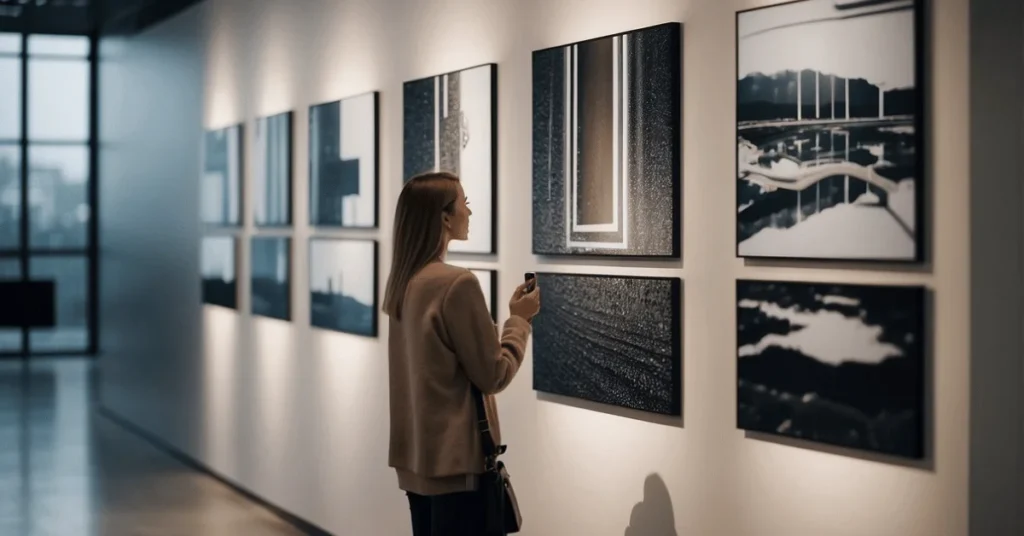
When we select wall art for our room, we focus on color coordination, decor matching, and optimal sizing and placement for a harmonious and sophisticated space.
Color Themes and Accents
In the realm of wall art, our choice of color plays a pivotal role in setting the tone of a room. We explore complementing the existing color palette, whether it’s the tranquility of blue tones or the stark simplicity of black and white photography. For example, a monochrome piece can stand out against a white backdrop, adding depth and interest.
Matching Art with Room Decor
We carefully pick art that aligns with the overall home decor’s style and aesthetic. The art should not only match in terms of color but also in spirit—contemporary minimalistic pieces harmonize well with modern, sleek furniture and accent pieces.
Sizing and Placement Tips
It’s crucial for us to consider the sizes of the pieces in relation to the space we have:
- Large walls benefit from oversized art or grouped galleries for a statement.
- Smaller spaces might prefer a single, smaller piece that complements without overwhelming the area.
Strategic placement enhances visibility and impact—eye level is best for engaging with the art. Our goal is to achieve a balanced look that resonates with the room’s existing decor and color schemes.
Selecting High-Quality Wall Art

Materials and Craftsmanship
The foundation of any exceptional piece of wall art lies in its materials. We prioritize high-quality materials like 100% real wood frames, which provide durability and a premium feel. These frames should exhibit excellent joinery and a smooth finish to complement the sleek look of minimalist art.
Understanding Art Print Techniques
Giclée printed artworks represent the pinnacle of print quality with rich, vibrant colors and sharp details. Giclée, a fine art printing technique, uses high-resolution digital scans to create reproductions that are virtually indistinguishable from the original.
- Advantages of Giclée Printing:
- Superior color accuracy
- High resolution that captures every detail
- Ability to reproduce fine art on various substrates
Importance of Fade-Resistant Inks and Papers
For wall art to stand the test of time, it must resist fading. We ensure that our minimalist art pieces use fade-resistant inksand archival paper or canvas. Archival inks and fade-resistant ink contribute to the longevity of prints, preventing color degradation from exposure to light and environmental factors.
- Characteristics of Fade-Resistant Inks and Archival Papers:
- Protects against UV rays
- Resists humidity and temperature fluctuations
- Maintains color integrity and vibrancy over extended periods
By understanding these aspects, we can confidently select wall art that not only beautifies spaces but also maintains its allure for years to come.
Popular Themes in Modern Minimalist Wall Art

Nature and Landscape Imagery
We find that nature and landscape imagery play a pivotal role in minimalist art. Themes such as beach scenes and mountain landscapes are frequently depicted with a restrained color palette. Watercolor techniques are particularly popular, as they can suggest natural elements like seascapes or forested areas with just a few strokes. This style allows us to appreciate the subtle beauty of nature without overwhelming detail.
Animal Silhouettes and Motifs
Minimalist art doesn’t shy away from the animal kingdom. In our work, animal silhouettes, especially those of dogs, are a beloved choice. The strength of a silhouette is in its simplicity; an outline can capture the essence of an animal with elegance and minimal line work. These motifs can range from the detailed and specific, capturing the spirit of Scandinavian design, to the more abstract, leaving much to our interpretation.
Urban and Architectural Elements
Our focus on sparse urban and architectural elements reflects a fascination with the man-made world. In minimalist art, we create cityscapes or architectural designs using simple, clean lines that highlight the beauty of human innovation. The simplicity of these elements within a piece can serve to remind us of the intersection between humanity and artistry.
How to Shop for Wall Art
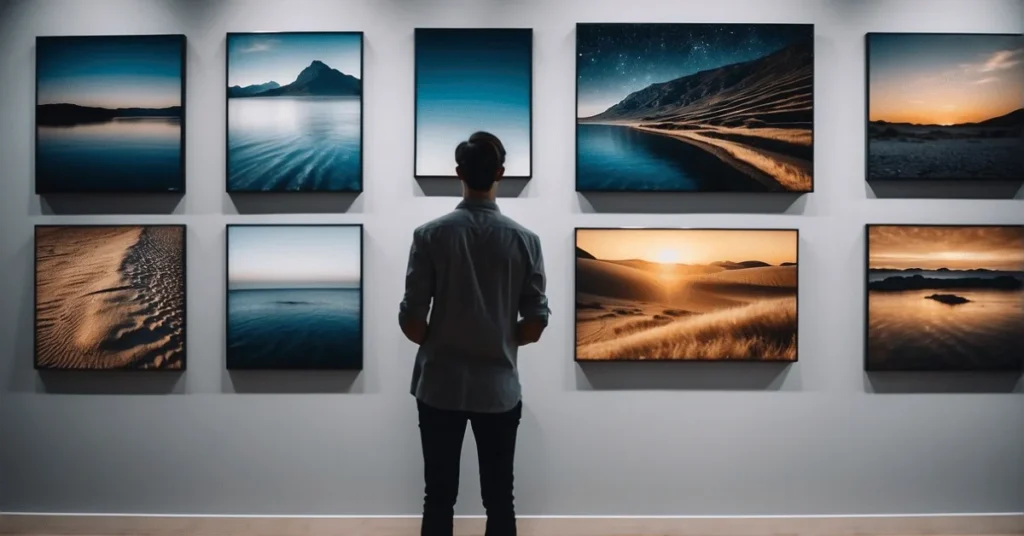
Online Marketplaces and Galleries
Exploring online marketplaces and galleries is a convenient way to discover a diverse range of modern minimalist wall art. For instance, Etsy is a treasure trove for unique and handmade items. On this platform, we can find a plethora of digital prints and original artworks that cater to the minimalist aesthetic. The key advantage is the direct contact with creators, which makes it possible to request custom pieces tailored to our preferences.
Tips for Buying Original Artwork
Purchasing original artwork merits specific considerations:
- Authenticity: Always verify the originality of a piece, especially if it’s from renowned artists like Pablo Picasso.
- Provenance: Request documentation that establishes the history of the artwork.
- Condition: Inspect images or descriptions for any damage if not viewing in person.
When engaging with sellers, clear communication about these details is crucial.
Finding Deals and Free Shipping Offers
To enhance the shopping experience, we should look for cost-saving opportunities:
- Deals: Sign up for newsletters from favorite online stores to receive updates on sales or exclusive discounts.
- Free Shipping: Some retailers, including those offering modern minimalist wall art, provide free shipping to incentivize purchases. It’s often wise to filter search results to highlight items with these offers, ensuring we get beautiful art delivered to our doorsteps without additional costs.
Wall Art Installation and Care
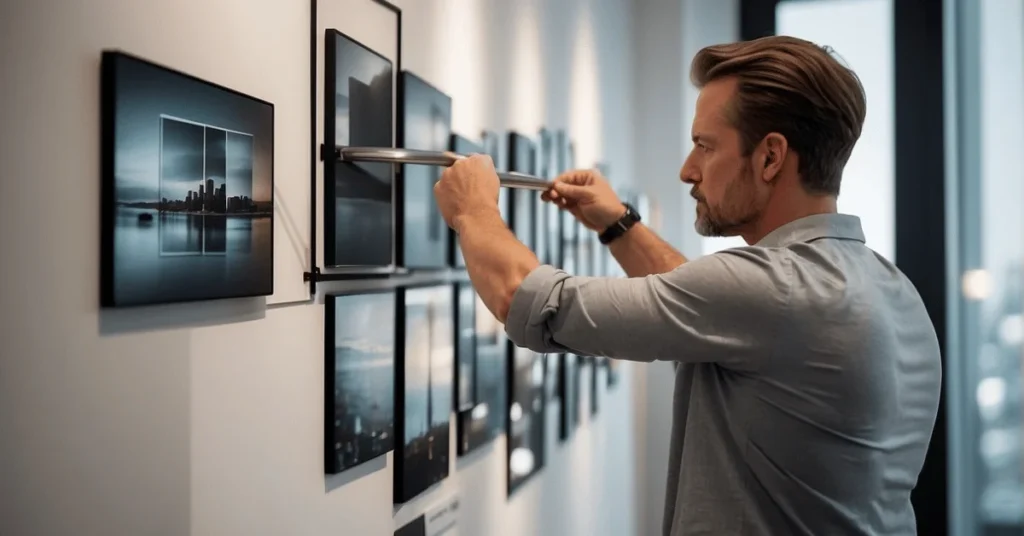
Proper Wall Mounting Techniques
Finding the right wall mounting hardware is crucial for a secure and visually appealing display. We always recommend using a stud finder to locate the sturdiest part of the wall for heavy pieces and ensuring that the hardware used can bear the weight of the artwork. For pieces that are ready to hang, ensure that the included hanging mechanisms, such as D-rings or sawtooth hangers, are properly aligned and firmly attached to the frame.
- Lightweight Art: Adhesive strips or mounting putty
- Medium Art: Nails or anchoring screws with wall plugs
- Heavy Art: Wall-drilling anchors, toggle bolts, or ceiling hooks for stability.
Maintenance for Longevity
To preserve the fade-resistant qualities of minimalist wall art, we advise placing it out of direct sunlight and in a controlled environment. Regular dusting with a soft, dry cloth is crucial to prevent build-up that could damage the surface over time. If the art features glass protection, a spritz of glass cleaner on a cloth (not directly on the glass) will keep it crystal clear.
Cleaning Schedule:
- Weekly: Light dusting
- Monthly: Check for signs of wear or damage
- Annually: Deep clean and inspect hardware
Arranging Art Sets and Collections
Arranging art sets, such as a set of 3, requires a keen eye for balance and spacing. We prefer to hang pieces at eye level, which is generally 57 inches from the floor to the center of the art. With collections, maintaining a consistent gap of 2-3 inches between each piece allows for a look that’s cohesive yet distinct. For uniformity, ensure that the center of each piece aligns horizontally or vertically, depending on the layout preference.
Spacing Guide for Collections:
- Horizontal Layout: Uniform gap 2-3 inches
- Vertical Layout: Align centers, consistent gap top to bottom
Trends and Innovations

As we explore the landscape of modern minimalist wall art, it’s evident that the interplay of emerging trends and innovative artistic methods is reshaping our visual environment. We’ll delve into the specific artists and styles on the rise, as well as how the digital realm is influencing the art that graces our walls.
Emerging Artists and Styles
We’re witnessing a surge of minimalist murals that redefine interior spaces with their subtlety and scale. Bright colors and graphic art prints are at the forefront, offering a visual punch that complements the minimalist ethos. Prominent in this trend is the adoption of black and white photography, providing a timeless quality that anchors a room. Some pieces make powerful statements with just a few strokes, while others weave complex narratives through simple forms.
- Bright colors often come in the form of block prints or abstract shapes, bringing energy to a minimalist setting.
- Graphic art prints present clean lines and bold forms, leveraging negative space to create impact.
The Influence of Digital Art and Photography
The digital medium has opened doors to new ways of creating and displaying art. Photography, particularly pieces that showcase stark landscapes or urban vistas, has seen a rise in popularity among minimalist enthusiasts. These images often highlight places with a keen sense of style, whether capturing the essence of a bustling city or the tranquility of nature.
Digital art allows for precise manipulation of elements, leading to innovative styles that merge the traditional with the new. The ability to experiment with digital tools means that artists can push the boundaries more than ever before.
- Photography: Emphasizing simplicity and composition, photographers are creating works that communicate more with less.
- Digital Art: Artists are harnessing technology to create minimalist art that resonates on both an aesthetic and an intellectual level.
Frequently Asked Questions
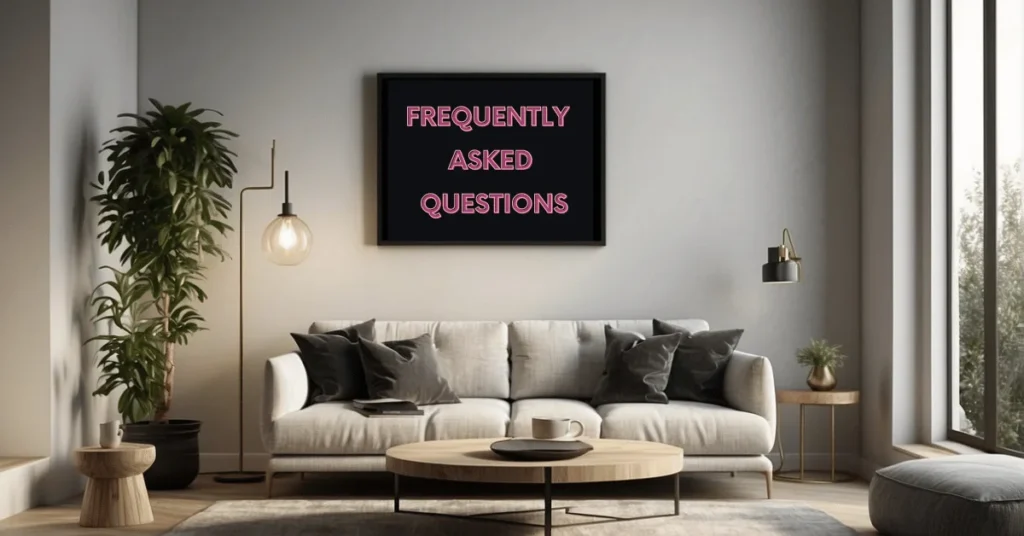
How do I choose the right size of modern minimalist wall art for my space?
When selecting modern minimalist wall art, consider the wall’s dimensions where the art will be placed. A general rule is for the art to cover 60-75% of the available wall space, creating a balanced look. For a cohesive appearance, leave ample space around the art to prevent a cluttered feel.
What are some popular trends in modern minimalist wall art for living room decor?
Recent trends in modern minimalist wall art for living rooms include oversized and centered pieces that act as a focal point. Monochromatic palettes, geometric designs, and nature-inspired motifs provide a sophisticated and contemporary aesthetic.
What is the difference between abstract minimalist art and other minimalist styles?
Abstract minimalist art emphasizes form and color, reducing subjects to their essential qualities without depicting real-world objects. Other minimalist styles might still reference recognizable forms and structures but simplify them to their bare elements.
How can I create a cohesive minimalist gallery wall with diverse pieces?
To create a cohesive gallery wall, maintain a consistent color scheme or frame style across the pieces. Align artworks along a central axis—either vertically or horizontally—and ensure even spacing between each piece to achieve a harmonious display.
What are some tips for incorporating minimalist wall art into a vintage-inspired interior design?
To incorporate minimalist art into a vintage design, choose artwork with a subtler color palette that complements the interior’s retro hues. Consider minimalist line art or simple black and white prints that can bridge the gap between modern and vintage elements.
Where can I find high-quality minimalist art prints for my home?
For high-quality minimalist art prints, look for reputable galleries or online platforms that specialize in contemporary art. Websites like Eden Gallery offer a range of modern minimalist pieces that highlight simplicity and elegance.
Thank you for joining us on this journey into the world of modern minimalist wall art. We’ve explored the elegance of simplicity in elevating spaces. Now, we want to hear from you!
Do you have personal tips or unique insights into integrating modern minimalist wall art into your space? Share your thoughts and be part of the conversation in the comments below!


